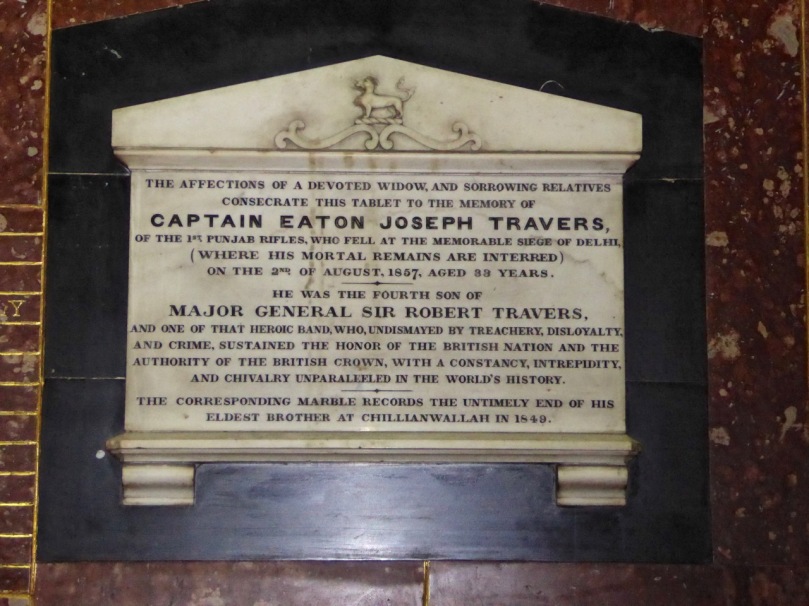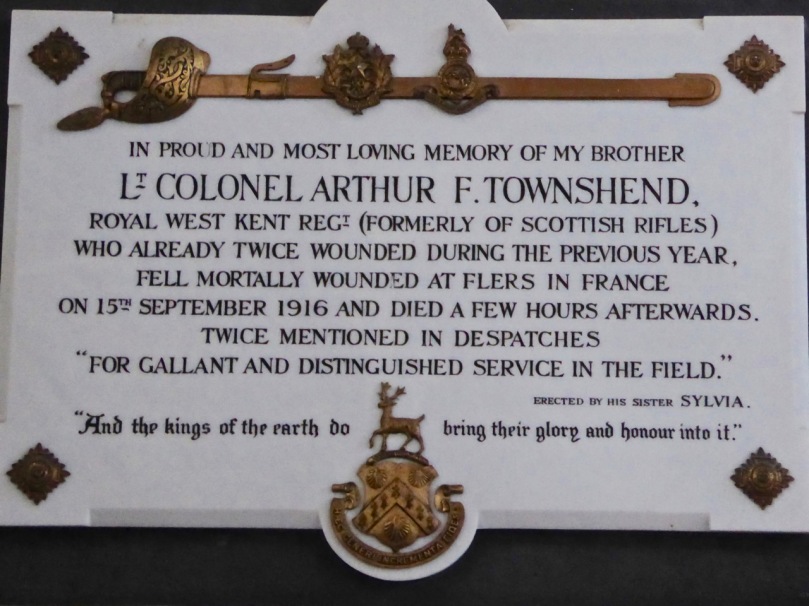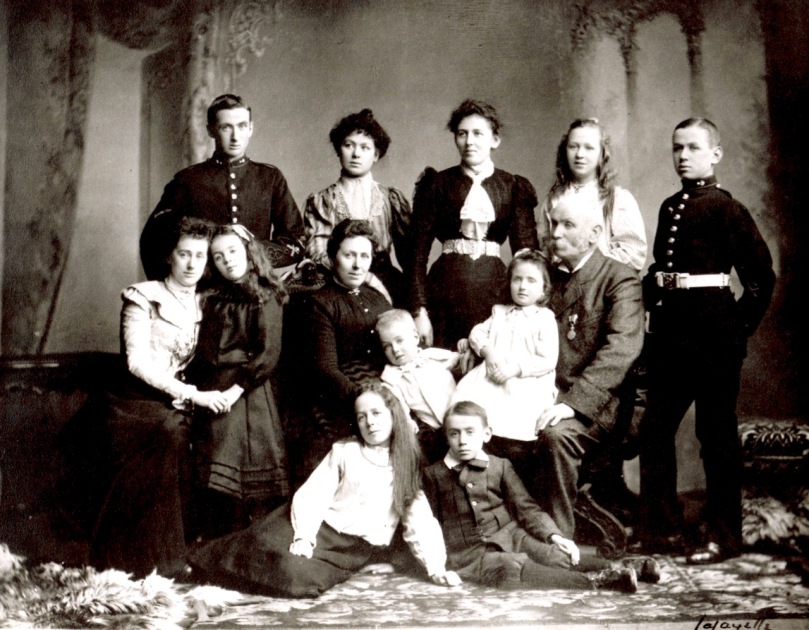There’s a class of monument in Ireland that I am only discovering as an adult. There is a reason for this – as a young person growing up in a conservative Catholic culture, it was verboten for us to enter (yes, even just enter) Protestant churches. I was used to a certain iconography – stations of the cross, statues, stained glass of saintly subjects – and very rarely did it include memorials to deceased individuals. That was confined to the graveyards.
No modern Irish reader of this memorial at St Fin Barre’s Cathedral in Cork could fail to be aware of its incongruities
As our readers will know by now, Robert and I never pass an open church without poking around inside. Last year, in The Love Which He Bare Her, I wrote about the wonderful memorials I have discovered to women, cataloguing their many virtues. That was for St Valentine’s Day so since it’s still February I thought I would do a similar post for men. There are lots – poets, priests and philosophers, benevolent and erudite – but the ones I have been most taken by are the military memorials* we have discovered in Protestant churches.
Irish men served in the British army all through our long and complex history together. My father served in the Second World War although he saw no combat. My maternal grandfather was a Sergeant in the Welsh Fusiliers stationed in Dublin where he met my grandmother, whose own father had served in India and Afghanistan.
Left: My father, Hugh Finlay, during his time in the British Army, stationed in Belfast during the Second World War. Right: The grave of my Welsh grandfather, William Owen Roberts, in The Hague, Holland. He saw action as a young man in the Boer War. He died of the Spanish Flu on his way home from the First World War.
Although this was part of family lore, it received no attention in our history lessons. Once again – there’s a reason for this. It’s been succinctly expressed by Turtle Bunbury in his book The Glorious Madness:
 For those who returned to Ireland after the war, the horror of their experience was magnified by the realisation that everything they fought for amounted to nought and that anyone who thought otherwise was no longer welcome. Although many of those who won independence for the Irish Free State had formerly served in His Majesty’s forces, there were powerful elements within the new order that would obligate the country at large to throw an unforgiving eye upon ex-servicemen of the British Empire. In time the hostility became amnesia and the Ireland of my youth in the late 20th century seemed to have a history in which the only war the Irish ever fought was for freedom from Britannia’s rule.
For those who returned to Ireland after the war, the horror of their experience was magnified by the realisation that everything they fought for amounted to nought and that anyone who thought otherwise was no longer welcome. Although many of those who won independence for the Irish Free State had formerly served in His Majesty’s forces, there were powerful elements within the new order that would obligate the country at large to throw an unforgiving eye upon ex-servicemen of the British Empire. In time the hostility became amnesia and the Ireland of my youth in the late 20th century seemed to have a history in which the only war the Irish ever fought was for freedom from Britannia’s rule.
Turtle’s book opens our eyes to the vast numbers of Irish men and women who fought in WWI and their reasons for doing so – reasons as diverse as their backgrounds. Read the chapter on Tom Kettle and Emmet Dalton, for example, or the piece on Liam O’Flaherty (author of The Informer) or that on Cork’s famous son, Tom Barry, as well as those on members of the Anglo-Irish aristocracy such as Lord Desmond FitzGerald, or famine-survival emigrants such as Knox D’Arcy who helped found BP Oil. Thankfully, the collective amnesia is being faced now and memorials to WWI dead are springing up in country graveyards around Ireland.
A new slab at Abbeymahon church near Courtmacsherry remembers Denis Driscoll, a local man who fought in WWI
Besides the first and second World Wars, though, the military memorials that have caught my eye have celebrated the courage and sacrifice of Irish men who devoted their lives to a career in the British army and navy even before the 20th century. But why are these memorials inevitably found in Protestant churches and not Catholic? Besides the conventions of iconography and the collective amnesia referred to above, there is, yes you guessed it, a reason for this.
As part of a minority but ruling class in Ireland, Church of Ireland members often saw themselves as standard bearers of Empire. As a community they were on the whole (with many notable exceptions) conservative and unionist and looked to Britain for education for their children. Many families had generations-long traditions of sending their sons to serve in the army or navy. (While Irish Catholics also served, it was predominantly in the ranks of foot-soldiers and to escape unemployment at home, rather than as career officers.) British military valour and sacrifice, therefore, loomed far larger in the consciousness of Protestant families than in Catholic ones.
According to Martin Maguire in his paper “Our People”; the Church of Ireland in Dublin and the culture of community since Disestablishment**, The most powerful and emotional bond with Great Britain, and within the Church of Ireland community in Dublin, were memories of the first World War… After the war Remembrance Day became one of the most solemn occasions in the year, one which strengthened the sense of being a special community and, despite national independence, maintained the close identity between the Church of Ireland and the community of the British Empire… The loss of a great many young men to a population which was already unstable was traumatic.
But this is also true of all the preceding wars, and this is reflected in the church memorials we see in the Protestant churches. Battles and engagements in places we never learned to think about about in school as being part of our collective heritage (the Burma War? the Siege of Lucknow?) are eulogised in these tablets and plaques. Soldiers are honoured by their companions, and lamented by their families. Their bravery and accomplishments are lauded and potent symbols such as crossed spears and empty helmets represent their sacrifice.
Being an ‘Outpost of Empire’ doesn’t sit well with our ideas of what Ireland is now and this year in particular we will be celebrating our independence from all that that phrase invokes. But these memorials serve to remind us of the complexity and plurality of our history, and in many case of our own family history.
The Brabazons, about 1900. Great-grandfather John Edward had served in India and Afghanistan and wears a military medal. Great-Uncles Michael and James wear the uniforms of army cadets***. Marie, my grandmother, who married William Owen Roberts, is in the middle at the back
*The Memorials in this post come from three churches: St Fin Barre’s in Cork City, St Barrahane’s in Castletownshend (Co Cork) and St Patrick’s Cathedral in Dublin.
**Available at: http://eprints.dkit.ie/75/1/Our_People_Laity_of_the_C_of_I.doc
** *More information from my cousin, Shauna: The two boys are wearing the uniform of the Royal Hibernian Military School. More information about that establishment here.











Whatever about memorials to individuals, I wonder about some of those memorials to battles in places like St. Patrick’s, and especially those regimental flags that are sometimes displayed inside churches. I know every army believes that God’s on their side, but does military imagery really belong inside a church of any denomination? There are some impressive monuments, all the same!
LikeLike
They certainly are extraordinary – the ones in St Patrick’s. Are such memorials found in churches elsewhere, I wonder.
LikeLike
I had three grand uncles from Naas, who served In WW1. One died (Gas), one shell shocked and the last buried the dead, married the local Sheriff’s daughter, then trained as an engineer rebuilding Coventry cathedral. But he ended up back in Paris running paramount pictures office!! He took 1million in gold bullion and hid it for the whole of world war 2 , paramount representatives could’nt believe it when they got back?? His name was Peterpurcell and we have letters from Bob Hope written to -Peter Purcell, Paramount Pictures, Paris!! and then, a wonderful bunch of cousins all over France and around the world!! So the war and those Irish who were drawn I to it, have grown more than a family!!
LikeLike
What a great story!
LikeLike
The first monument in the article above relates to the “China War” of early 1840’s. This is the First Opium War, fought so that Britain could force China to accept the trade in narcotics which the Empire forced Indian farmers to grow, in place of their traditional food crops, so that British narcotics pushers could grow fabulously rich by rotting and poisoning the bodies and minds of Chinese people.
The second monument celebrates so-called Indian Mutiny of 1857, which Indians call their First War of Independence. About sixty “brave Irishmen” were awarded the Victoria Cross during the military campaign that followed the Indian Mutiny.
A letter published after the 1857 fall of Delhi in the ‘Bombay Telegraph’, and subsequently reproduced in the British press, testified to the scale of the massacres carried out by British troops: ‘All the city people found within the walls (of the city of Delhi) when our troops entered were bayoneted on the spot, and the number was considerable, as you may suppose, when I tell you that in some houses forty and fifty people were hiding. These were not mutineers but residents of the city, who trusted to our well-known mild rule for pardon. I am glad to say they were disappointed’.
Fanatical blood-lust saturated the Empire. Charles Dickens said: ‘I wish I were commander-in-chief in India … I should proclaim to them that I considered my holding that appointment by the leave of God, to mean that I should do my utmost to exterminate the race.’
Should we now condemn the Irish people who participated in these and other British war crimes? We should certainly not praise them.
LikeLike
Thank you, Eamonn, for those erudite and thoughtful comments. We can neither praise nor condemn if we don’t first acknowledge their existence.
LikeLike
Your blog appeared on my fb feed and as I have only just set up my wordpress account I was delighted to be able to follow you. My 18 year old daughter had the opportunity last year to represent Kerry in a group of All Ireland students who researched a soldier who died in The Great War and then visited their grave in Northern France. The soldier she researched was from a Catholic family and his Nephews and Nieces had only just become aware the same year that they had an uncle who died in the war. As a result of her project the family discovered they also had another uncle who served and survived. This shows the Amnesia as something as big as that in a family had been forgotten within two generations. Also, my boyfriends Mother, who is in her 80s, only discovered last year that her own Father had fought in WW1. It was never discussed.
LikeLike
Lovely to meet a fellow West Cork blogger! Thanks for your comments – a valuable addition to this topic.
LikeLike
While I can’t say that I know of any direct Irish ancestors who fought in these world wars, I also found it moving. I have both German and English ancestors besides the Irish, and I can say that I’m proud of each branch. One grandfather fought in the Boer War and WW 1, and I found this information only as an adult. I certainly wish I’d been able to thank him for his sacrifices, but I just didn’t know. Thanks for sharing the Irish perspective…we are all God’s children, and I hope that more people would feel free to enter churches, either Protestant or Catholic.
April in Canada
LikeLike
Thanks so much for your comments. There’s no problem now with entering any church – all those prohibitions disappeared a long time ago. It seems so much from another time now.
LikeLike
Some prohibitions were put into place with a very good reason behind them. For centuries Catholicism was oppressed as we all should know and the cruelty inflicted on the Irish needs to be addressed and made public rather than left hidden. One pressing issue is the enslavement of Irish under Cromwell and their shipment to Barbados.
LikeLike
I enjoyed your piece on the British “Imperial” monuments in W Cork.
I recall that when I was working for a major IT company in UK on MoD projects I mentioned to my boss that we owned a little place in W Cork and went there for holidays, he replied, “Ah! Obviously, Castletownsend”.
I explained, “No so”,. & that we had a bungalow on a little cove almost S of Ballydehob.
He was perplexed. His surprise was explained when we had a look at the monuments in the well-preserved Anglican church in Castletownsend, when we saw his surname on a monument from for ages ago & then I remembered that his father had served in WW2 and had been promoted as the RN’s First Sea lord, “The Chief of the Queen’s Navy”.
His was a Royal Navy family from way-back-when.
More surprisingly, we saw graves at Castletownsend of military men (yes, men) that are much more recent. I can’t recall details quite senior RAF officers, for example.
Did the UK military association at Castletownsend continue?
LikeLike
As far as I know, several of the Castletownsend families had long-term connections with the army and the navy. Sad story – Vice-Admiral Boyle Somerville was shot by the IRA for “recruiting local young men for the British navy.” The people of Castletownsend were appalled by this heinous crime and set up a fund for a memorial for him. I am thinking about a post on him at some point – he was an archaeologist, among other things.
LikeLike
I’m another one that cannot pass a church, mainly to admire the architecture. But I enjoyed your write-up on the information found inside the churches, or gravestones. There sure is a lot to interest anyone around West Cork.
LikeLike
I never thought I would find myself writing about graveyards and church memorials! But it’s amazing what you find when you dig a little.
LikeLiked by 1 person
My dad was in WW1. Battle of the Somme and survived. His dad was killed by the Germans on MV Leinster. His body was never found. Freedom from tyranny comes in many forms.
LikeLike
How very true, Denis.
LikeLike
Well, isn’t history just a wonderful thing to study – and if you keep an open mind it will no longer be the propaganda of the victor ! The contribution of Irish men and women to what we now call the free world has been immense, and not always celebrated enough, for one reason or another. I found this post very moving, actually, and it resonated with so much that I already know and think. But there is always so much more to know ! Well done Finola, and let us so conduct ourselves that there will be no more misery in the cause of any empire.
LikeLike
Well said, Julian! Thank you for saying you found it moving. It was surprisingly so to research and write.
LikeLike
Slightly shocked to read about the never ever entering a Protestant church bit – such a Christian attitude! I see it worked both ways though! Some very beautiful memorials here and good to know that finally Irish people can be proud of their ancestors who fought for the Empire. The photo of your Brabazon ancestors is wonderful.
LikeLike
Not sure if ALL Irish people want to be ‘proud’ of ancestors fighting for the Empire – but we do need to acknowledge them, understand what motivated them, and recognise their courage and sacrifice.
LikeLike
Yes, I think that’s what I meant!
LikeLike
And I, as Finola’s Protestant cousin, growing up in Dun Laoghaire was told that if I went into a Roman Catholic church the roof would fall in!
LikeLiked by 1 person
Two Solitudes.
LikeLike
Reblogged this on West Cork History.
LikeLiked by 1 person